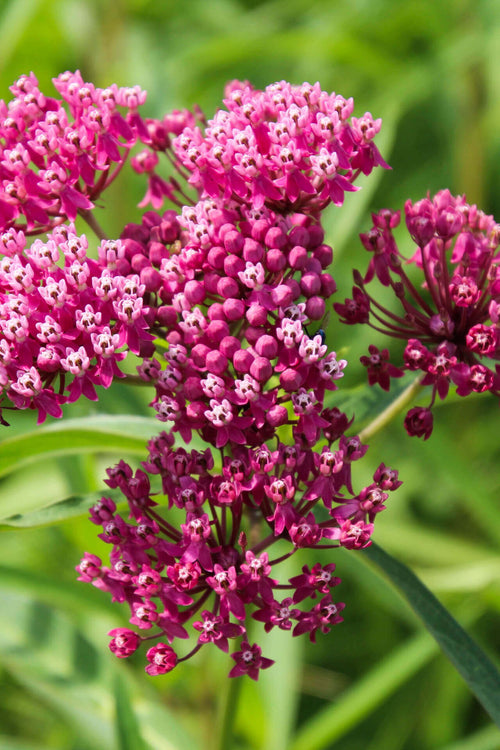Milkweed Plant
Milkweed plant is known for attracting monarchs, the milkweed plant is a native perennial that has clusters of showy, pink to mauve flowers and lance-shaped leaves, attracting a host of pollinators while thriving in moist, wetland habitats. They boast numerous benefits when incorporated into landscaping designs. Its unique features contribute to outdoor spaces' aesthetic appeal and ecological value. With clusters of vibrant and captivating flowers, it adds a burst of color and charm to gardens while also serving as a vital component in supporting local ecosystems.
The Common Milkweed is the plant that most people think of when the term ‘milkweed’ comes to mind. It is a tall plant that is noted for its pink to purple flowers. It’s one of 115 species of plants of the Asclepiadaceae family. The genus Asclepias is named after Asklepios, who was the Greek god of medicine.
This is appropriate because it is known for containing high levels of cardiac glycosides, which are used in some treatments for heart disease. This same substance also serves as the only source for Monarch butterfly larvae.
Where Does Milkweed Grow?
It is native to the midwestern and eastern regions of the United States and Canada, but it can be found further west as well.
It is most commonly found in more open habitats like pastures, prairies, fields, and along roadsides. It needs total sun to grow but can tolerate being under light shade as well.
You’ll normally find it commonly clustered together into large patches, which are called colonies.
Description of Milkweed
It can grow to be over five feet tall. The foliage can grow up to 8 inches, elongated nearly four inches wide, and is somewhat thick.
The upper part of the oval-shaped leaves is usually darker greenish in color, while the underside of the leaves is a much lighter green and sometimes even white. Both the leaves and the stems will reveal a milky latex when they are cut.
The flowers themselves can grow to be nearly an inch long and half an inch wide with a midrib that runs beneath them. They have a pink to purple coloring over them with a greenish tint and are very sweetly scented.
Why Gardeners Like Milkweed
The pink-to-purple colors contrast well against lush green fields and dry yellow prairies alike. Gardeners like it for its distinctive appearance and sweet, fragrant aromas.
Another reason why gardeners often like it is that it serves as the host plant for the beautiful monarch butterfly. These butterflies will lay their eggs on it, and as mentioned previously, the nectar also serves as the only source of food for the Monarch larvae.
Gardeners who like monarch butterflies or are otherwise concerned about their declining population can grow it to provide these butterflies with a natural habitat.
The Milkweed plant is a flowering perennial named for its cardenolide-bearing latex, which is beneficial to butterflies and other insects. Monarch butterflies use and require specific species, including Asclepias syriaca and Asclepias incarnata, as host plants. Their genus name, Asclepias, honors Asklepios, the Greek god of medicine.
Asclepias contains hundreds of species native to Africa, North America, and South America. Asclepias syriaca and Asclepias incarnata are native to the American continents and common across the central and eastern United States. The sun-loving Asclepias syriaca grows naturally in fields, prairies, and pastures, while Asclepias incarnata grows along creeks, ponds, and bogs. Their flowers typically bloom from June through August.
Asclepias produces complex blossoms that have similarities to orchids. Their large, spherical clusters of five-petaled blossoms are found at the top of it's thick stems. Each Asclepias growth usually carries two to five clusters of flowers. The individual blossoms are about three-quarters of an inch long and emit a strong, sweet fragrance. Asclepias syriaca has greenish-pink to rosy pink blooms, while Asclepias incarnata's flowers tend toward a brighter purplish-pink hue.
It can grow up to five feet tall. Their thick, bright green leaves are six to eight inches long and two to three-and-one-half inches wide. The leaves' upper surfaces are darker than their whitish undersides.
In nature and in landscapes, Asclepias plants form colonies and need room to spread out. Asclepias incarnata is highly ornamental and fairly easily contained, making it well-suited to perennial, butterfly, and pollinator gardens. Asclepias syriaca works well in meadow gardens without defined borders. They grow easily from seed and spread as their rhizomes expand. They can be propagated in the late fall or early spring.
Ecology Of Milkweed Plant
Asclepias syriaca and Asclepias incarnata are the required food sources for monarch butterflies, beetles, moths, and other insects that evolved to feed on their nectar. In the midwestern and northeastern regions of the United States, their leaves are the most important source of nourishment for monarch caterpillars, and their presence helps to fortify and increase monarch populations.
Planting Milkweed Plant Will Bring the Butterflies to Your Garden
If you want to encourage monarch butterflies and other pollinators to make your garden home, you'll surely want to add Asclepias to your landscape.



















































